Ely Cathedral and the Stained Glass Museum
by Sean McLachlan
If you are in Cambridge and you are interested in an enjoyable day trip filled with history, you might want to consider a visit to Ely, a small cathedral town of about 15,000 people. The town lies amidst farm fields and pasture 16 miles northeast of Cambridge and is an easy 25 minute drive by car or 15 minutes by train.
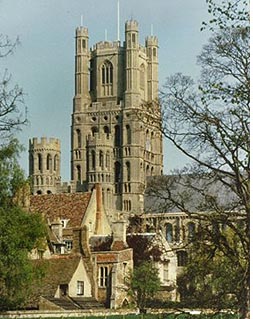 Ely was originally called the "Isle of Ely" because it stands on high ground that used to be surrounded by fens. The fens weren't drained until the 18th and 19th centuries, when the moist soil became fertile farmland. Even today the countryside gets quite muddy after a rain. Hikers beware! Ely was originally called the "Isle of Ely" because it stands on high ground that used to be surrounded by fens. The fens weren't drained until the 18th and 19th centuries, when the moist soil became fertile farmland. Even today the countryside gets quite muddy after a rain. Hikers beware!
When the area was still an island, it was already an important center for agriculture and trade. Archaeologists have found settlements dating as far back as the Bronze Age. The Romans had a town there too, but Ely became first rose to notoriety in Anglo-Saxon times when Etheldreda, a Saxon princess, converted to Christianity. She married in 652 and received the Isle of Ely as her dowry. Her first husband died and she married again before eventually retiring to Ely to devote her life to worship. She founded a monastery there in 673. Etheldreda became the abbess and was later canonized. She was said to have died a virgin despite having been married twice. In fact, her chastity was the main reason her second husband let her leave! A village grew up around the monastery and became Ely.
Ely grew to be an important religious and cultural center and became an Anglo-Saxon stronghold during the Norman invasion. Taking advantage of the isle's natural defenses, Anglo-Saxon war leader Hereward the Wake (which means "watchful" in Old English) held off the Norman army for years until betrayed by the monks at Ely monastery in 1071. The monks feared that continued resistence would result in the destruction of their monastery, so to save themselves they showed the Normans how to navigate through the fens and take the isle.
The Ely cathedral is the seat of the Bishop for the Diocese of Ely. The present structure was begun in the 11th century, although much was added to it or altered in subsequent centuries. The cathedral was restored in the year 2000 and is a fine example of Norman and Gothic architecture, with a massive square tower and an octagonal tower with graceful spires reaching towards the sky. Owing to the flat terrain and its great height, 215 feet, the Norman-style Great West Tower is visible from quite a distance away and makes for a fine sight in the evenings as the sun sets over the countryside.
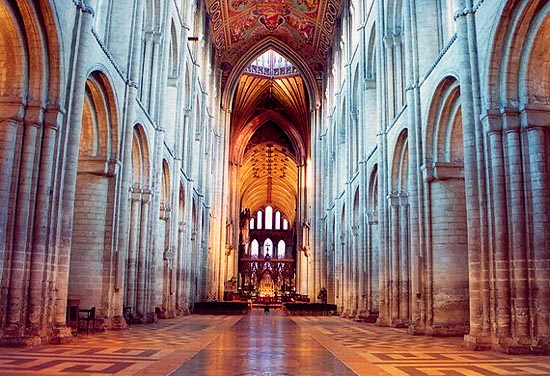
The entrance is through a graceful double Gothic archway. Once inside, many visitors enter the labyrinth set out in tiles on the floor. Labyrinths are found in many medieval cathedrals and are currently enjoying a revival with pilgrims and tourists. They are meant as aids to meditation. This isn't actually a maze, but a unicursal labyrinth, meaning a "one-way path." The point isn't to figure out the way through, but to follow a winding course that takes one in a meandering path to the center. While working their way from the outside of the labyrinth to the center, pilgrims are supposed to think about the spiritual symbolism of its complex passages and elegant symmetry. Interestingly, the distance required to walk the labyrinth is the same as climbing the Great West Tower.
The lofty ceiling, which on sunny days seems to almost float on the shafts of light coming through the broad windows, was elaborately painted in Victorian times. The detailed scenes show the Creation of the world and the Ascension of Christ, along with other Biblical scenes.
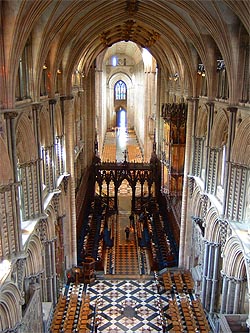 A later, smaller chapel, called The Lady Chapel in honor of the Virgin Mary, was added in the 14th century. The interior vault is a fine example of Gothic architecture. The statues here are in poor condition and seem to have been purposely broken. Local legend says this was done by Oliver Cromwell's soldiers. Cromwell ordered the cathedral closed for ten years because he did not like its "Popish" decoration. During that time he used it as a stable for his cavalry. Cromwell wasn't able to destroy the excellent acoustics, though, and a choral performance here is well worth going to. The chapel has a seven-second echo, meaning that talented singers can actually sing duets with themselves. A later, smaller chapel, called The Lady Chapel in honor of the Virgin Mary, was added in the 14th century. The interior vault is a fine example of Gothic architecture. The statues here are in poor condition and seem to have been purposely broken. Local legend says this was done by Oliver Cromwell's soldiers. Cromwell ordered the cathedral closed for ten years because he did not like its "Popish" decoration. During that time he used it as a stable for his cavalry. Cromwell wasn't able to destroy the excellent acoustics, though, and a choral performance here is well worth going to. The chapel has a seven-second echo, meaning that talented singers can actually sing duets with themselves.
With fair weather it is possible to climb either tower and catch stunning views of the town and countryside. The best time to do this is around sunset, when the golden light on the surrounding fields and rooftops makes for a memorable experience. Availability is limited so it's best to call ahead. The climb is moderately strenuous.
In the south transept of the cathedral is the Stained Glass Museum, with a fascinating collection of stained glass from the middle ages up to the present day. The collection is mounted on a series of panels and lit from behind to good effect. The oldest specimen in the museum, dating from c.1200-1250, actually looks quite modern. Its latticework design makes it more Art Nouveau than medieval. A pair of windows depicting St. Catherine and St. Lawrence from c. 1310-1330 look more like one expects from medieval art. The two saints wear period costume and are shown with the various symbols of their sainthood. Catherine is holding a little wagon wheel, since she achieved her martyrdom by being strapped to a wheel and beaten until her body was broken. In medieval times she became the patron saint of wheelwrights. St. Lawrence is holding the gridiron on which he was roasted to death. Both windows, which hung in a Cambridgeshire church for many years, have deep, warm colors typical of the period. More brilliant colors are to be found in the 16th century coats of arms from Switzerland. The complex designs are made up of symbols depicting the history and supposed personal traits of various noble houses.
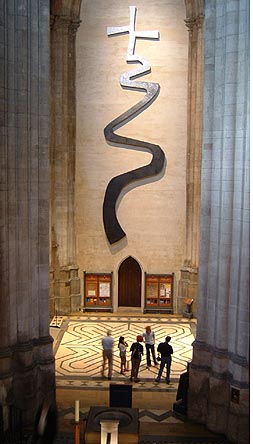 One surprise in this museum is the excellent collection of relatively recent stained glass that shows the art has not died out. There is a portrait of King George III from 1793, copied from a painting in the King's Dining Room of Windsor Castle. The craftsman copied the texture and color of the original paints so well that it almost looks like an oil painting. The Dance of Salome, made in 1856 during the French Gothic Revival, looks very medieval but has the vibrant colors of a modern work. The works from the 1920s and 1930s are especially expressive and show various figures in an Art Nouveau style. The figures in a Virgin and Child window made in 1930 are especially good, with a mournful Virgin looking at her baby as if she knew what his fate would be. The most recent piece in the collection is a Virgin and Child made by British artist Benjamin Finn. The work looks strikingly medieval and is modeled on an Eastern Orthodox icon. One surprise in this museum is the excellent collection of relatively recent stained glass that shows the art has not died out. There is a portrait of King George III from 1793, copied from a painting in the King's Dining Room of Windsor Castle. The craftsman copied the texture and color of the original paints so well that it almost looks like an oil painting. The Dance of Salome, made in 1856 during the French Gothic Revival, looks very medieval but has the vibrant colors of a modern work. The works from the 1920s and 1930s are especially expressive and show various figures in an Art Nouveau style. The figures in a Virgin and Child window made in 1930 are especially good, with a mournful Virgin looking at her baby as if she knew what his fate would be. The most recent piece in the collection is a Virgin and Child made by British artist Benjamin Finn. The work looks strikingly medieval and is modeled on an Eastern Orthodox icon.
There is a tea room and restaurant located in the 12th century crypt. In the summer, weather permitting, there is seating in a pleasant garden. Once the visit and the tea are done, try a stroll around the surrounding neighborhood. Many of the buildings date from the medieval period and the narrow lanes make for an atmospheric walk. If you have the time, stroll down to the Ely Tourist Information Centre, housed in the home of Oliver Cromwell and an interesting example of traditional English wood frame architecture. There is a museum onsite.
Ely Cathedral is open from 7 am to 7 pm every day in the summer months, and in the winter is open 7:30 am to 6 pm Monday through Saturday and 7:30 am to 5 pm Sundays. This is a functioning house of worship so at times there will be services in session. Admission is £4.80, concessions £4.20, children under 12 free. Guided tours are available every day. Tours of the Octagon Tower are available from March 31 to November 2 and cost £4, or £3 with the purchase of a cathedral ticket. Tours of the Great West Tower are available during the same period and cost £3.50, or £2.50 with the purchase of a cathedral ticket. The tea room and restaurant generally have the same hours as the cathedral but can be shorter at times.
In the summer, the Stained Glass Museum is open 10:30 am to 5 pm Monday through Friday, 10:30 am to 5:30 pm Saturday, and noon to 6 pm Sunday. In the winter months hours are 10:30 am to 5 pm Monday through Saturday, and noon to 4:30 pm Sunday. Last admissions are 30 minutes before closing. Admission is £3.50 for adults, £2.50 concessions. Guided tours are available by prior arrangement. No photography is permitted in the gallery.
Ely Cathedral Photo Gallery
by David Alcock
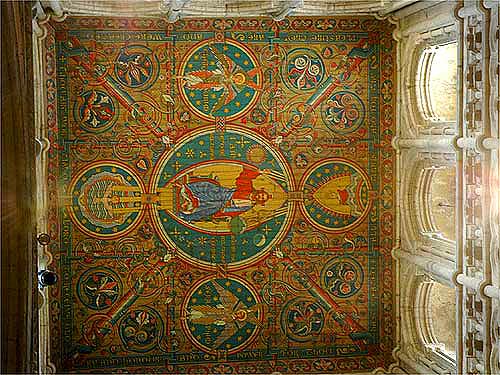
The West Tower |
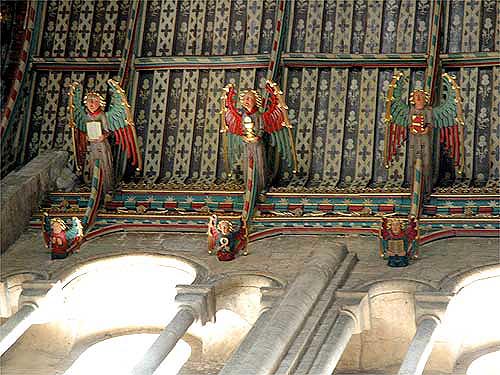
The North Transept forms the oldest part of the Cathedral that is still standing, and dates from around 1090. A close-up picture of the 15th Century rooves, shows it decorated with angels. |
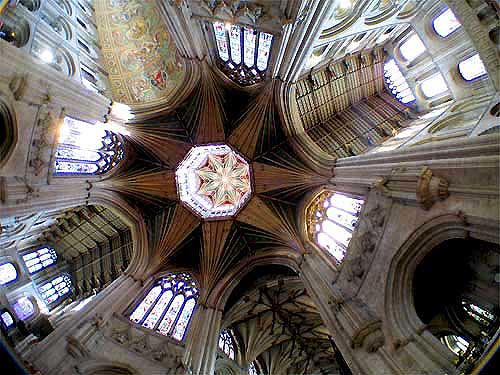
In 1322 the Norman central tower collapsed. Alan of Walsingham, and William Hurley created this massive central tower. Eight huge pillars support 200 tons of timber, glass and lead, hanging in space: a major feat of engineering. |
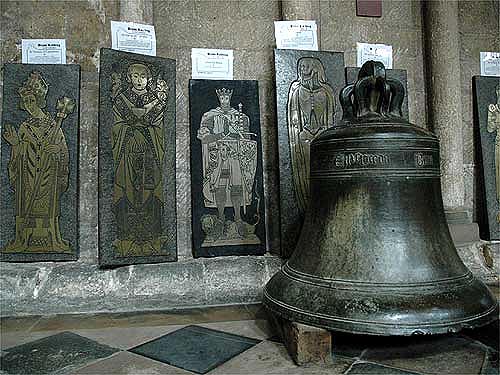
Some of Ely's past visitors. |
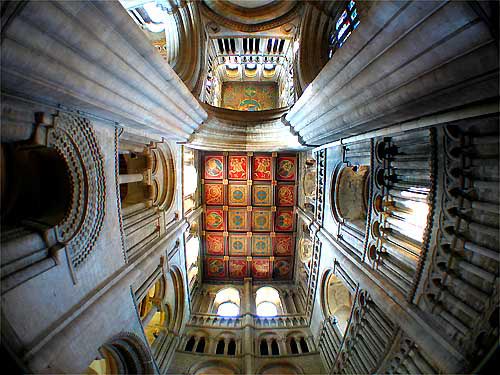
Above the West Tower, 215 ft (66m) high. Completed in the late 14th Century. |
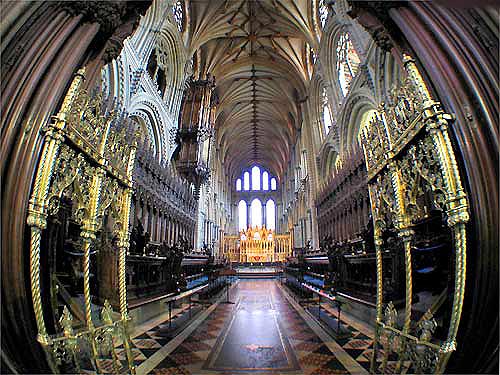
Pearly Gates into the Choir, rebuilt in the 14th Century.
|
More Information:
We regret that we no longer have the resources to maintain up-to-date links and/or hours and pricing details for the various sites and attractions listed on this website. For more information about the location(s) listed above, please use your favorite search engine or visit Wikipedia.
 |
Sean McLachlan is a freelance writer specializing in travel and history. He has written several books including Byzantium: An Illustrated History (Hippocrene, 2004) and Moon Handbooks London (Avalon, 2007). Visit him on the web at http://midlistwriter.blogspot.com.
|
Article © 2005 Sean McLachlan
Photos courtesy of Ely Cathedral; "Photo Gallery" courtesy of David Alcock, aka "Cragface."
|
